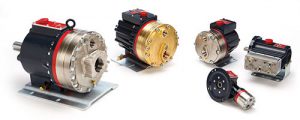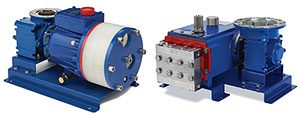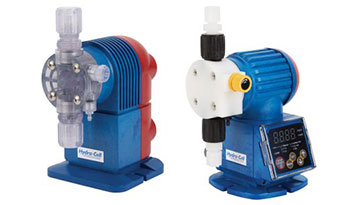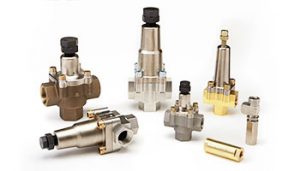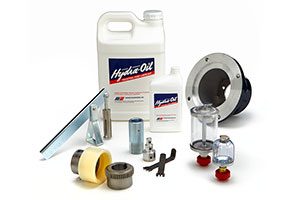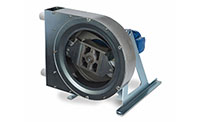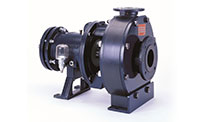Regeneration Application
A large electronics manufacturer was having pump problems with their acid regeneration system when they had inconsistent performance and premature failure of their chemical feed pumps. Hydra Cell D10 size acid pumps with variable speed drives would handle the required flow rate of 4-6 GPM (15-23 l./min). Hydra-Cell acid pumps were installed to adjust the pH levels of the process fluid by dosing in acid or caustic as required. Hastelloy and Viton XT were selected for the sulfuric acid, and stainless steel acid pumps fitted with EPDM were selected for the sodium hydroxide. Due to the corrosive nature of the process solutions, the end user required the acid pumps be fitted with ANSI flanged connections for the inlet and outlet ports. This custom feature is available in stainless and alloy D10, H25, and D35 acid pumps from Wanner Engineering. Manifolds ports are socket welded with full penetrate welds on all weld neck flanges and elbows.
Acid Reclamation Saves Costs for Precision Machining
A precision machine shop specializing in STEM (Shaped Tubular Electro Machining) manufacturing used for "drilling" high tolerance holes that conform to curved profiles. The hole follows a curved path and can reach "depths" of 18 inches (46 cm). This tight tolerance work is more of a "guided machining" process rather than actual drilling.
The machine shop uses special titanium tubes with an insulated coating for creating these holes. Warm sulfuric acid (15-19%, 100°F, 38°C) is pumped through these tubes at 75 psi (5 bar) to dissolve the alloy. A strong electric current charges the tip of the tube to accelerate the process. The tube never actually comes in contact with the part maintaining tight tolerances in these curvy holes. The tolerances are checked by x-ray to verify that the hole is being formed correctly. Acid formulation, tube feed rate, and other variables are precisely controlled for the various alloys being machined. While this is a relatively expensive way to machine parts, it is the only way to manufacture some of the complex parts used in turbines and jet engines. As the acid consumed the metal, the conductivity of the acid changes and as such cannot be reused. In the past, small quantities of the acid were neutralized and hauled away for disposal. As acid usage increased along with the cost of treatment and disposal, it became necessary to install a membrane filter system to reclaim the acid. As much as 90% of the acid can be reused utilizing this on sight system. The filter system was originally supplied with a multi-stage centrifugal pump. The pump immediately developed leaks and frequent repairs (with different seals) proved fruitless. The intermittent duty cycle with long periods of down time proved fatal for the multi-stage pump.
Frustrated, the OEM of the filter system reviewed the situation and suggested a Hydra-Cell® acid pump model H25EFTGTTTTB. The Hastelloy and Viton XT pump is directly driven at 1160 RPM and delivers 20 GPM (76 l./min) at a variable pressure of 350-490 PSI (24-34 bar). The crew at the machine shop has confidence in the filter system operation and increased its usage to maximize acid reclamation and reduce the amount of new acid purchased. The Hydra-Cell acid pump is at the heart of this acid reclamation system and has paid for itself many times over!
Hydra-Cell® Diaphragm Pump Advantages
The seal-less nature of the Hydra-Cell diaphragm pumps enable charged and dirty liquids to be processed without need for fine filtration to protect the diaphragm pump.
The Hydra-Cell diaphragm pump needs little maintenance and can operate at continuous duty at high pressure.
Pulsation is low, so dampeners may not be required for most Hydra-Cell® diaphragm pumps.
Hydra-Cell® diaphragm pumps can handle solids up to 500 microns, or more. They can be pumped without fine filtration. System costs are reduced and maintenance is simplified.
Most diaphragm pumps in the Hydra-Cell® diaphragm pump range can operate at any pressure from <1 bar up to at least 70 bar. Some models up to 170 bar.
Seal-less design distinguishes the Hydra-Cell® diaphragm pumps from other diaphragm pumps and is the basis of its long service life - many of the liquids pumped are harmful to pump seals. The Hydra-Cell® diaphragm pumps are tolerant of small solids, resistant to chemical and corrosive attack.
Energy savings. Compact and highly efficient (80-85%), a Hydra-Cell® abrasive pumps can be fitted with a smaller motor than would be required by many much bigger hot water pumps for equivalent flows and pressures.

